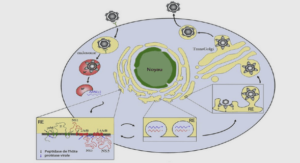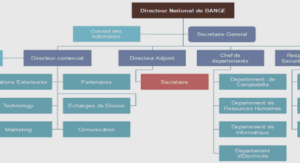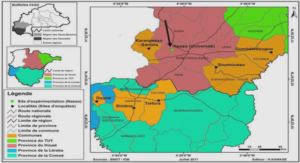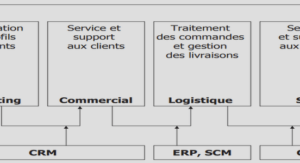Déformation et anisotropie du manteau
lithosphérique sous un rift mature
Le rift Est-Africain est l’un des principaux rifts actifs de la planète. Il offre la possibilité d’étudier le rifting à différents stades de maturité, de l’initiation jusqu’à l’accrétion océanique. Si des études ont apportées des contraintes importantes sur la déformation de surface et le magmatisme durant le rifting, ainsi que le rôle des panaches mantelliques (e.g. Biggs et al., 2011; Corti, 2008; Ebinger et al., 1993; Stewart et Rogers, 1996), peu de choses sont connues sur la manière dont le manteau accommode la déformation durant le rifting. La présence de magmas à petite échelle peut diminuer de façon significative la viscosité du manteau (Hirth and Kohlstedt, 2003; Kohlstedt and Zimmerman, 1996; Kohlstedt et al., 2000; Zimmerman and Kohlstedt, 2004). Or, la partie éthiopienne du rift Est Africain a été soumise à plusieurs épisodes magmatiques importants. La formation rapide du plateau magmatique Ethiopien il y a 30 Ma (Ebinger, 1993; Georges et al., 1998; Hofman et al., 1997) a précédé un second épisode volcanique et de début de l’extension au Miocène (Ebinger et al., 1993; Hendrie et al. 1994; Morley et al. 1992). Enfin, la région enregistre un dernier épisode volcanique PlioPléistocène, se traduisant sous la forme de cônes et de fissures volcaniques au cœur de la vallée du rift (Bonini et al., 2005; Ebinger et al., 1993; Furman, 2007; Shinjo et al., 2011). Le travail présenté dans ce chapitre repose sur l’analyse de 25 xénolites mantelliques (20 péridotites, 5 pyroxénites) du rift Est-Africain au Sud de Mega, en bordure Sud du plateau éthiopien. Cette étude est basée sur la caractérisation des microstructures et des OPRs des xénolites éthiopiens, ainsi que le calcul de leurs propriétés sismiques. Elle vise à mieux comprendre les relations entre déformation et percolation de fluides et magmas durant le rifting. Les péridotites du Sud de Mega présentent des microstructures homogènes, suggérant que ces roches n’enregistrent probablement pas de variations spatiales ou temporelles des conditions de déformation. Contrairement à ce qui a précédemment été rapporté par Bedini et al. (1997), nous n’observons pas de variations significatives des microstructures en fonction du type de métasomatisme. La variation de l’espacement entre sous-joints dans les Déformation et anisotropie du manteau lithosphérique sous un rift mature porphyroclastes d’olivine, ainsi que la polygonisation variable des néoblastes d’olivine, suggèrent une déformation suivie par un recuit variable. Les OPRs de l’olivine de type orthorhombique indiquent une déformation par fluage-dislocation avec activation du système de glissement [100] (010). La présence de clinopyroxène et d’orthopyroxène suggère une cristallisation secondaire, probablement associée à l’épisode métasomatique identifié par Bedini et al. (1997). Les OPRs mesurées dans l’orthopyroxène et parfois dans le clinopyroxène, ainsi que la cohérence généralement observée entre les OPRs de l’olivine et de l’orthopyroxène, indiquent un épisode métasomatique pré- à syn-cinématique. L’anisotropie azimutale maximale des ondes P varie entre 3.1 et 12.3%, tandis que l’anisotropie de polarisation maximale des ondes S est comprise entre 2.9 et 8.3%. De telles anisotropies ne peuvent expliquer à elles seules les déphasages des ondes SKS mesurées au niveau du rift Ethiopien et du rift Kenyan. Les microstructures et les relations entre magmas et percolation dans les péridotites éthiopiennes sont différentes de celles observées dans les xénolites de la Divergence Nord-Tanzanienne ou du Nord Kenya. La comparaison de ces données indique que, bien que la percolation de magmas dans le manteau lithosphérique durant le rifting soit commune, son timing par rapport à la déformation varie.
Deformation and anisotropy of the lithospheric mantle beneath a mature rift: constraints from mantle xenoliths from Southern Mega, SE Ethiopia
The East African rift is great natural laboratory, which allows studying continental rifting at variable degree of maturity, from its initiation to oceanic accretion. Over the past years, studies have brought important constraints on surface deformation and magmatism during rifting, as well as on the role of mantle plumes (e.g. Biggs et al., 2011; Corti, 2008; Ebinger et al., 1993; Stewart et Rogers, 1996). Despite this, little is known about how the lithospheric mantle accommodate rifting deformation through time. Many studies point out the major role of magmas during rifting initiation and formation. Buck (2006), for instance, proposed that dyke intrusions might help initiating the deformation within the strong continental lithosphere. This hypothesis is supported by seismic anisotropy studies, which suggest the presence of oriented melt pockets in the crust and the mantle within the rift axis in Ethiopia and in Afar (Bastow et al., 2010; Hammond et al., 2014). At a larger scale, bodywave tomography images a broad and deep low velocity anomaly beneath the Ethiopian Plateau and the eastern branch of the rift system in Kenya and Tanzania, that have been proposed to be linked to the African Superplume (Nyblade, 2011). The presence of magma at a smaller scale may significantly decrease mantle viscosity (Hirth and Kohlstedt, 2003; Kohlstedt and Zimmerman, 1996; Kohlstedt et al., 2000; Zimmerman and Kohlstedt, 2004). Reaction with melts or fluids may as well reduce mantle strength through crystallization of weaker phases, grain size reduction, and phase mixing (e.g., Dijkstra et al. 2002; Soustelle et al. 2010). In Ethiopia, the rapid formation of the magmatic Plateau during a plume-related peak volcanism at 30 Ma (Ebinger, 1993; Georges et al., 1998; Hofman et al., 1997) preceded continental extension initiation and a later volcanic episode in the Miocene (Ebinger et al., 1993; Hendrie et al. 1994; Morley et al. 1992). The Ethiopian branch of the East African Rift, the main Ethiopian rift, is therefore an ideal location to study the way the lithospheric mantle accommodated the rifting deformation in a mature rift and the role of magmatism in this process. In the present study, we explore the relation between deformation and melt percolation in a suite of mantle xenoliths from the southern end of the main Ethiopian rift (South of Mega, Sidamo region). Based on their crystallographic preferred orientations and mineralogical compositions, we also estimate their seismic anisotropy and compare it to seismic anisotropy data performed in the area.
Geological background
Geological setting
The East African rift is one of the most active rifts on Earth. It extends over more than 4000 km, from the Afar triple junction to the Gulf of Mozambique, and splits into two branches around the Tanzanian craton. The Eastern branch and the main Ethiopian rift of the East African rift overlap in the Turkana Depression, a 300 km wide system of extensional basins (Shinjo et al., 2011), where the earliest traces of volcanic activity (45 Ma) in the East African rift system were found (Ebinger et al., 1993, Georges et al., 1998). Extension in the main Ethiopian rift started in South Ethiopia at ~25-20 Ma (Ebinger et al., 1993; Hoffman et al., 1997; Kieffer et al., 2004; Woldegabriel et al., 1991), through the thick Ethiopian plateau, which formed from a peak volcanic activity at 31-30 Ma. The region also records two later, lower volumes, volcanic episodes: one during the Miocene (19-11 Ma) dominated by alkaline basalts and trachytes, and another during the Plio-Pleistocene, occurring as fissural lavas and cinder cones within the rift axis (Bonini et al., 2005; Ebinger et al., 1993; Furman, 2007; Shinjo et al., 2011). Seismic studies have investigated the structure of the Ethiopian rift. Joint inversion of Rayleigh wave group velocities and receiver functions indicate lithospheric thicknesses of 80- 90 km beneath the Ethiopian Plateau (Dugda et al, 2007). In the lithospheric mantle, maximum S-waves velocities of 4.3 km/s and 4.1-4.2 km/s are measured beneath the Ethiopian Plateau and the main Ethiopian rift, respectively (Dugda et al, 2007). Based on 1D conductive thermal model, Dugda et al. (2007) suggested that a plume model could explain this structure, provided that the lithosphere was thinned by ~30-50 km, above a plume during the flood basalt volcanism at 30 Ma, and the warm material stayed beneath the lithosphere since then. Beneath the Ethiopian Plateau, body-wave tomographies also image a 500 km wide and 400 km thick anomaly at ~100-300 km depth, interpreted as the upper mantle continuation of the African Superplume (Bastow et al., 2008, Benoit et al., 2006). Within the main Ethiopian rift, SKS studies report coherent rift-parallel polarization of the fast S-wave (Gashawbeza et al., 2004; Kendall et al., 2005), but variable delay times (0.5-1.7s: Gashawbeza et al., 2004, 1-3 s: Kendall et al., 2005). Variations in splitting parameters and increasing amount of splitting above regions of recent volcanism support the idea of an anisotropic signal dominated by oriented melt pockets (Ayele et al., 2004; Kendall et al., 2005). However, beneath the Ethiopian plateau, the measured anisotropy may be related to a pre-existing fabric frozen in the lithosphere (Gashawbeza et al., 2004; Hammond et al., 2014). Surface waves and SKS studies report the presence of a ~100 km thick anisotropic upper layer (Bastow et al., 2010; Hammond et al., 2010; Sicilia et al., 2008), possibly caused by a fossil fabric (Sicilia et al., 2008), which locally contains oriented melt pockets (Bastow et al., 2010; Hammond, 2014; Sicilia et al., 2008). A more recent SKS study shows the existence of two anisotropic layers (Hammond et al., 2014): an upper layer with variable polarization directions in the Ethiopian plateau and the main Ethiopian rift, and lower anisotropic layer with a consistent NE-SW orientation that could be attributed to flow from the African Superplume. In the Sidamo region (South Mega, SE Ethiopia), on the southern border of the Ethiopian plateau and the southern end of the Ethiopian rift, lava flows and pyroclastic rocks with basanitic to nephelinitic compositions erupted in the late Pleistocene, carrying mantle xenoliths (Morten et al., 1992; Bedini et al., 1997). The present study focuses on twenty-five mantle xenoliths from this region (Fig. 1)
Sample set: geochemical background
The geochemical composition of the studied mantle xenoliths has been previously studied in detail (Bedini, 1994; Bedini et al., 1997; Bedini et al., 1999; Lorand et al., 2003). Bedini et al. (1997) showed that beneath south Mega, the lithospheric mantle was infiltrated by asthenospheric magmas linked to a mantle plume. During their upward migration, these magmas reacted with the surrounding peridotite, which progressively modified their composition, generating different types of metasomatism along the percolated column and through time (Bedini et al., 1997). Bedini et al. (1997) indeed identified two geochemical groups among the peridotites from south Mega: (1) The less recrystallized samples (or “deformed”), strongly enriched in LILE, with negative anomalies of the HFSE and sometimes apatite-bearing, (2) The more recrystallized samples (or “granular”), depleted or slightly enriched in LILE and devoided of significant HFSE anomaly. The geochemical characteristics of “deformed” peridotites were interpreted as the result of interaction with small fractions of LILE-enriched melts saturated in Ti-oxides, while “granular” peridotites are believed to have re-equilibrated with high fractions of basaltic melts (Bedini et al., 1997). In deformed peridotites, PGE abundances and sulphides modal compositions suggest interaction with volatile-rich small melt fractions (Lorand et al., 2003), while in granular peridotites, reequilibration with OIB-like melts in high porosity zones at the bottom of the lithosphere is likely. Because our observations and interpretations on sample microstructures are significantly different than that of Bedini et al. (1997), we will refer in the following to “deformed” peridotites as “metasomatism 1” (M1) peridotites and to granular peridotites as “metasomatism 2” (M2) peridotites.





